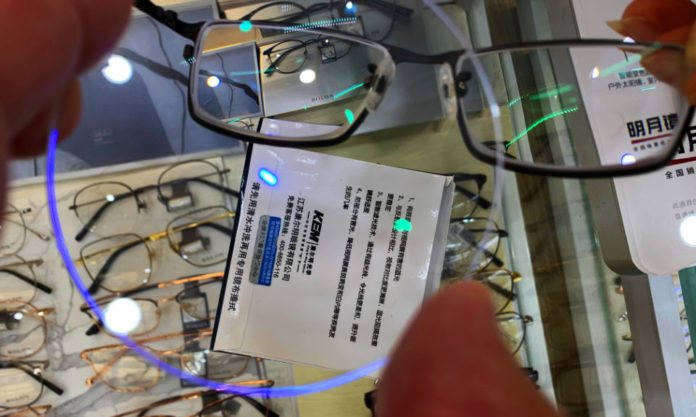Counters showcasing anti-blue-light glasses have started popping up in opticians all over China. The nation’s top ophthalmologists, however, say there is no scientific basis for such offering any benefit to those spending long periods of time looking at screens.
Hazards to grandchildren are a favourite topic for older Chinese women in their lecturing of their children. As the young ones spend more and more time looking at screens, so the amplification of gossip has led to the widespread belief that blue light causes blindness.
“Online class partner to relieve visual fatigue” is one of the many advertising slogans for anti-blue ray glasses that have appeared in recent weeks. They claim to be able to “block 95 percent of blue light” or “effectively prevent myopia”. Naturally some command high prices, being allegedly imported from the United States, Germany or Japan.
The wavelength of blue light is in the range of 380-500 nanometres. Its primary source is sunlight, while others include fluorescent lamps and LED screens. Far from being anything to fear, the intensity of blue light from a smartphone screen is only one hundredth or even one thousandth that in natural light.
For anyone who does not work in a strong blue-light environment, such as on an ocean surface, near icebergs and/or snow all year round, or those who use a computer for less than 10 hours a day, including minors who are online students, blue light is nothing to worry about.
Results from tests conducted previously by the China Consumers Association on a representative range of electronic products also show that blue-light values are within the safe range.
- Eye of the Tiger; The Business of Myopic China
- China Dumps Glasses; Falls in Love with Contacts
- Obesity, myopia main health problems facing Jiangsu youngsters
It may not come as a surprise that a number of lens manufacturers have revealed that the claim, “Blocks 100 percent of blue light”, is more than a lie. The president of a prominent local lens producer told reporters for The Paper that many of their competitors claim to sell “foreign brand” anti-blue light glasses which are actually produced in China.
The president also pointed out that these types of lenses often block the beneficial part of blue light as well. For minors still in the stage of development, long-term wear of such anti-blue ray glasses may result in vision loss and damage to biological rhythms.
Chen Zhijun, Director of the Department of Ophthalmology in Nanjing Children’s Hospital, said, “Excessive interception of blue light affects melatonin secretion and interferes with sleep”.
The fact is, China has had a high rate of myopia since long before the advent of the smartphone.
The rate of myopia in China is, in fact, so skewed that it is one and a half times more than the world average; 33 percent versus 22 percent.
As long ago as 2017, this very publication published a growing body of evidence that suggests the large occurrence rate may, in fact, have little to do with study or smartphones, and be more down to the fact that many Chinese spend long periods indoors in poor lighting conditions.
Professor Ian Morgan, of the Research School of Biology, Australian National University, Canberra, and the Zhongshan Ophthalmic Centre, Sun Yat-sen University, Guangzhou, spoke at length with The Nanjinger at the time. His epidemiological studies estimate children should spend approximately 3 hours each day in sunlight in order to be protected against myopia.
Chen agrees with Morgan. “Instead of wearing anti-blue light glasses, it is better to bathe in the sun for 2 hours a day”, he said.
With children spending much of this year to date tackling online learning, the “Guidelines on the Prevention of Myopia during the Novel Corona Pneumonia Outbreak in Children and Adolescents (Updated Version)” proposes that children and adolescents choose electronic products with large screens, high screen resolutions and suitable definitions as much as possible. During use, they should adjust the brightness to make the eyes feel comfortable; not too bright or too dark.
Wei Wenbin is Director of the Department of Ophthalmology in Beijing Tongren Hospital. He advocates a “20-20-20” formula for the use of electronic products. After looking at a screen for 20 minutes, look away at something else that is at least 20 feet (6 metres) away for more than 20 seconds.









